Comprehensive Guide to Foot and Ankle Anatomy and Conditions
Walking is one of the first major milestones in life. Our feet and ankles are critical to our daily activities, from simply walking around our home or workplace, to more strenuous physical exercise. Whether it’s an injury, underlying condition, or just wear and tear, problems with the foot and ankle are incredibly uncomfortable, debilitating, and painful. Simply put, if walking is hard, going about most of your day will be too. We’re here to help you get back on your feet, so you never miss a step.
To help you discuss foot and ankle conditions and treatment options with your surgeon, here’s a breakdown of the anatomy of the foot and ankle.
Guía Integral de la Anatomía y Condiciones del Pie y el Tobillo
Caminar es uno de los primeros hitos importantes en la vida. Nuestros pies y tobillos son fundamentales para nuestras actividades diarias, desde caminar por nuestra casa o lugar de trabajo, hasta realizar ejercicios físicos más exigentes. Ya sea por una lesión, una condición subyacente o simplemente por el desgaste, los problemas en el pie y el tobillo son increíblemente incómodos, incapacitantes y dolorosos. En pocas palabras, si caminar es difícil, la mayor parte de su día también lo será. Estamos aquí para ayudarle a volver a ponerse de pie, para que no se pierda ni un solo paso.
Para ayudarle a discutir las condiciones y opciones de tratamiento del pie y tobillo con su cirujano, aquí hay un desglose de la anatomía del pie y el tobillo.
- AnatomyAnatomía
- Conditions Condiciones
- Procedures Cirugías
Anatomy of the Foot & Ankle
The foot and ankle is a complex joint that provides movement, stability, and balance to the body. It consists of 26 bones, 33 joints, and many muscles, tendons and ligaments.
Bones of the Feet
The foot acts as a single functional unit, but can be divided into three parts:
The hindfoot forms the ankle and heel, and is made up of the talus bone and calcaneus, or heel bone. The heel bone is the largest bone in the foot.
The midfoot connects the hindfoot to the forefoot, and consists of one navicular bone, one cuboid bone, and three cuneiform bones.
The forefoot forms the arch of the foot for shock absorption while walking or running, and is made up of five metatarsal bones. Each toe is made of three phalanges, except the big toe, which has two phalanges, as well as two small sesamoid bones in the ball of the foot.
Bones of the Ankle
The ankle joint connects the leg with the foot and is composed of three bones:
The tibia, or shinbone, and the fibula, or calf bone, are bones of the lower leg which articulate with the talus, or ankle bone, enabling up and down movement of the foot.
Ankle and Foot Joints
There are 33 joints in the ankle and foot, and include:
- Hinge joints in the ankle, which allow flexion (bending) and extension.
- Gliding joints in the hindfoot, which allow gliding movements.
- Condyloid joints in the forefoot and toes, which allow the flexion (bending) and extension, adduction and abduction (sideward movement).
- Articular cartilage is a thin, tough, flexible, and slippery surface that lines the joint surface of all ankles and bones. It absorbs shock and reduces friction between the bones.
Ligaments of the Foot and Ankle
The ligaments of the foot and ankle connect bones together and provide stability to the joints. The Plantar fascia is the largest ligament in the foot, and stretches and contracts to provide balance and strength to the foot. Lateral ligaments on the outside of the foot and medial ligaments on the inside of the foot provide stability and allow up and down movement of the foot.
Muscles of the Foot
The foot is made up of 20 muscles, which include:
- Anterior tibial muscle allows up and down movement of the foot.
- Posterior tibial muscle supports the arch.
- Peroneal tibial muscle controls movement on the outside of the ankle.
- Extensors enable the ankle to raise the toes just before stepping forward.
- Flexors stabilize the toes against the floor.
- Smaller muscles help the toes lift and curl.
Tendons of the Foot and Ankle
Tendons of the foot and ankle connect muscles to bones. The largest and strongest tendon in the foot is the Achilles tendon, present at the back of the lower leg around the heel bone. Other tendons include peroneals and anterior and posterior tibialis.
Other Soft Tissues of the Foot and Ankle
Bursae are small fluid filled sacs that decrease friction between tendons and bone or skin.
Cartilage provides cushioning between the bones allowing for smooth movement.
If you’re missing a step due to foot and ankle problems, conditions, or injuries, we’re here to help. Get back on your feet and back to living your best life.
Anatomía del Pie y el Tobillo
El pie y el tobillo forman una articulación compleja que proporciona movimiento, estabilidad y equilibrio al cuerpo. Consiste en 26 huesos, 33 articulaciones y muchos músculos, tendones y ligamentos.
Huesos del Pie
El pie actúa como una unidad funcional única, pero puede dividirse en tres partes:
- Retropié: forma el tobillo y el talón, y está compuesto por el hueso astrágalo y el calcáneo, o hueso del talón. El hueso del talón es el hueso más grande del pie.
- Mediopié: conecta el retropié con el antepié y consta de un hueso navicular, un hueso cuboide y tres huesos cuneiformes.
- Antepié: forma el arco del pie para absorber impactos al caminar o correr, y está compuesto por cinco huesos metatarsianos. Cada dedo del pie está formado por tres falanges, excepto el dedo gordo, que tiene dos falanges, así como dos pequeños huesos sesamoideos en la zona del metatarso.
Huesos del Tobillo
La articulación del tobillo conecta la pierna con el pie y está compuesta por tres huesos:
- La tibia, o hueso de la espinilla, y el peroné, o hueso de la pantorrilla, son huesos de la pierna inferior que se articulan con el astrágalo, o hueso del tobillo, lo que permite el movimiento hacia arriba y hacia abajo del pie.
Articulaciones del Tobillo y el Pie
Hay 33 articulaciones en el tobillo y el pie, que incluyen:
- Articulaciones de bisagra en el tobillo, que permiten la flexión (doblamiento) y la extensión.
- Articulaciones deslizantes en el retropié, que permiten movimientos de deslizamiento.
- Articulaciones condiloides en el antepié y los dedos, que permiten la flexión, la extensión, la aducción y la abducción (movimiento lateral).
- Cartílago articular: es una superficie delgada, resistente, flexible y resbaladiza que recubre la superficie articular de todos los tobillos y huesos. Absorbe impactos y reduce la fricción entre los huesos.
Ligamentos del Pie y el Tobillo
Los ligamentos del pie y el tobillo conectan los huesos entre sí y proporcionan estabilidad a las articulaciones. La fascia plantar es el ligamento más grande del pie y se estira y contrae para proporcionar equilibrio y fuerza. Los ligamentos laterales en el exterior del pie y los ligamentos mediales en el interior proporcionan estabilidad y permiten el movimiento hacia arriba y hacia abajo del pie.
Músculos del Pie
El pie está compuesto por 20 músculos, que incluyen:
- El músculo tibial anterior permite el movimiento hacia arriba y hacia abajo del pie.
- El músculo tibial posterior sostiene el arco.
- El músculo peroneo controla el movimiento en la parte externa del tobillo.
- Los extensores permiten que el tobillo levante los dedos justo antes de dar el paso hacia adelante.
- Los flexores estabilizan los dedos contra el suelo.
- Los músculos más pequeños ayudan a levantar y curvar los dedos.
Tendones del Pie y el Tobillo
Los tendones del pie y el tobillo conectan los músculos con los huesos. El tendón de Aquiles es el tendón más grande y fuerte del pie, ubicado en la parte posterior de la pierna inferior, alrededor del hueso del talón. Otros tendones incluyen los peroneos y los tibiales anterior y posterior.
Otros Tejidos Blandos del Pie y el Tobillo
Las bursas son pequeños sacos llenos de líquido que reducen la fricción entre tendones, huesos o piel.
El cartílago proporciona amortiguación entre los huesos, permitiendo un movimiento suave.
Si está perdiendo pasos debido a problemas, condiciones o lesiones en el pie y el tobillo, estamos aquí para ayudarlo. Vuelva a ponerse de pie y a vivir su mejor vida.
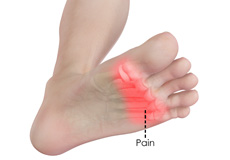
Foot Pain
Foot pain occurs from distress induced by certain factors in the foot. It is a common problem experienced by young athletes involved in various activities such as running and jumping.

Heel Pain
The heel is made up of the calcaneus bone and supported by a network of muscles, tendons, ligaments and soft tissues, which together support the weight of the body and stress during movement. Heel pain is a common symptom of excessive strain placed on these structures.
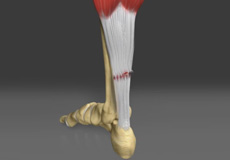
Achilles Tendon Rupture
The Achilles tendon is a strong fibrous cord present behind the ankle that connects the calf muscles to the heel bone. It is used when you walk, run and jump. The Achilles tendon ruptures most often in athletes participating in sports that involve running, pivoting and jumping.
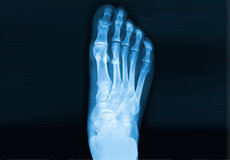
Foot Fracture
The foot has 26 bones, and can be divided into 3 parts:
- The hind foot is comprised of two bones, the talus bone which connects to the bones of the lower leg, and the calcaneus bone which forms the heel.
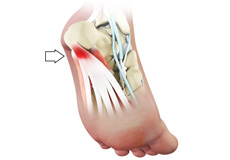
Plantar Fasciitis
Plantar fasciitis refers to inflammation of the plantar fascia, a thick band of tissue that is present at the bottom of the foot. It runs from the heel bone to the toe and forms the arch of your foot. Plantar fasciitis is one of the most common causes of heel pain. It is most often seen in middle-aged men and women, but may also occur in those who are constantly on their feet.
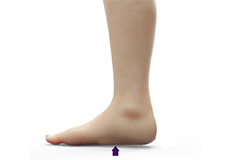
Flatfoot
Flatfoot, also known as “fallen arches” or Pes planus, is a deformity in children’s feet in which the arch that runs lengthwise along the sole of the foot has collapsed to the ground or not formed at all. Flatfoot is normal in the first few years of life as the arch of the foot usually develops between the age of 3 and 5 years.
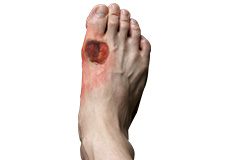
Diabetic Foot
Diabetes is a chronic condition that is characterized by high blood glucose (sugar) levels. Diabetic patients are at a high risk for developing chronic wounds, especially in the feet. If left untreated, these wounds can cause serious problems that can lead to infections and eventually gangrene, which may require amputation.
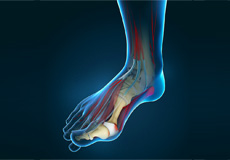
Bunion
A bunion is a bony protuberance that appears on the outer surface of the big toe when it angles toward the adjacent toe. It is an extra bone and a fluid-filled sac that grows at the base of the big toe.
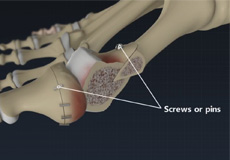
Hammertoe
A hammertoe is a deformity of a lesser toe (second through fifth toes), where the toe is bent upward at the toe's middle joint, resembling a hammer. The bent portion may rub against a shoe causing pain, irritation and development of corns.

Ingrown Toenail
An ingrown toenail is a common and painful condition of the toe. It occurs when the sides or corner of the nail grow inwards and penetrate the skin of the toe. Pain is often accompanied by swelling and redness. The big toe is affected most often.
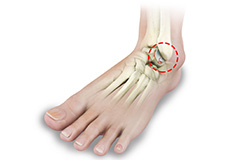
Foot & Ankle Arthritis
Arthritis is inflammation resulting from the degeneration of cartilage in the joint causing joint pain, swelling, and stiffness resulting in restricted movements. Arthritis of the foot and ankle joint can occur due to fractures, dislocation, inflammatory disease, or congenital deformity.
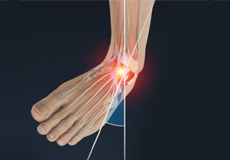
Ankle Sprain
A sprain is the stretching or tearing of ligaments, which connect adjacent bones and provide stability to a joint. An ankle sprain is a common injury that occurs when you suddenly fall or twist the ankle joint or when you land your foot in an awkward position after a jump. Most commonly it occurs when you participate in sports or when you jump or run on a surface that is irregular.
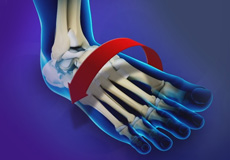
Ankle Instability
Ankle instability is a chronic condition characterized by a recurrent slipping of the outer side of the ankle. It usually results from repeated ankle sprains. It is generally noticed during movement of the ankle joint but can also occur during standing as well.
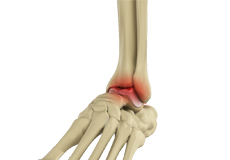
Ankle Arthritis
Arthritis is inflammation resulting from the degeneration of cartilage in the joint causing joint pain, swelling, and stiffness resulting in restricted movements. Arthritis of the foot and ankle joint can occur due to fractures, dislocation, inflammatory disease, or congenital deformity. The joint between the shinbone (tibia) and ankle bone (talus) is commonly affected by arthritis.
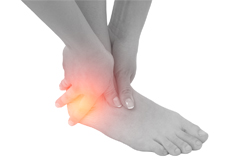
Sports Injuries
Sports injuries occur when playing indoor or outdoor sports or while exercising. They can result from accidents, inadequate training, improper use of protective devices, or insufficient stretching or warm-up exercises. The most common sports injuries are sprains and strains, fractures and dislocations.
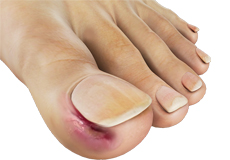
Toenail Conditions
Nails are an extension of the top layer of the skin and are composed of a nail plate (top layer) and nail bed (skin below the nail plate). The nail matrix is the region where your toenail begins to grow. Nails are made of keratin (protein) and help to protect your fingers and toes from injury. Toenail conditions can range from minor infections to severe trauma.
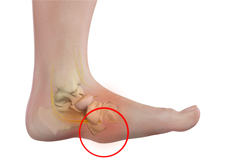
Nerve Conditions
The foot is composed of bones, ligaments, nerves, muscles, and tendons. Nerve conditions of the foot can range from minor nerve injuries to serious conditions like nerve entrapment and damage. A podiatrist is a doctor specializing in the treatment of foot problems including nerve conditions.
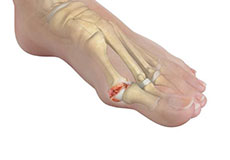
Hallux Rigidus (Big Toe Arthritis)
Hallux rigidus is a form of arthritis affecting the big toe joint, also known as the first metatarsophalangeal (1st MTP) joint. This condition causes stiffness, joint pain, and limited motion, especially during walking or bending activities.
We're dedicated to empowering you with the knowledge you need to make informed decisions about your orthopedic care. Below, you'll find comprehensive guides on common conditions and treatment options, designed to help you manage your health and recovery.
Foot & Ankle Conditions
Explore detailed information and home therapy tips for some of the most common foot and ankle issues:
- Ankle Sprain Home Therapy : Step-by-step guide to at-home recovery.
- Ankle Sprains : Causes, symptoms, and treatment options.
- Bunions : Understanding bunion causes and surgical/non-surgical treatment options.
- Hammertoe : Overview of symptoms and effective treatment strategies.
- Insertional Achilles Tendinitis : Treatment options for pain and inflammation at the heel.
- Peroneal Tendinitis : How to manage and treat this common overuse injury.
- Pinsite Care for External Fixation : Proper care to avoid complications after surgery.
- Plantar Fasciitis : Treatment and stretching program.
- Posterior Tibial Tendinitis/Flat Foot : Understanding flat foot conditions and available treatments.

Dolor de Pie
El dolor de pie ocurre debido a molestias inducidas por ciertos factores en el pie. Es un problema común experimentado por jóvenes atletas involucrados en diversas actividades como correr y saltar.

Dolor de Talón
El talón está compuesto por el hueso calcáneo y sostenido por una red de músculos, tendones, ligamentos y tejidos blandos, que juntos soportan el peso del cuerpo y el estrés durante el movimiento. El dolor de talón es un síntoma común de la tensión excesiva ejercida sobre estas estructuras.

Rotura del Tendón de Aquiles
El tendón de Aquiles es una fuerte cuerda fibrosa presente detrás del tobillo que conecta los músculos de la pantorrilla con el hueso del talón. Se utiliza cuando caminas, corres y saltas. El tendón de Aquiles se rompe con mayor frecuencia en atletas que participan en deportes que implican correr, pivotar y saltar.

Fractura de Pie
El pie tiene 26 huesos y se puede dividir en 3 partes:
El retropié está compuesto por dos huesos, el hueso astrágalo que se conecta con los huesos de la pierna, y el hueso calcáneo que forma el talón.

Fascitis Plantar
La fascitis plantar se refiere a la inflamación de la fascia plantar, una banda gruesa de tejido que se encuentra en la parte inferior del pie. Se extiende desde el hueso del talón hasta los dedos y forma el arco de tu pie. La fascitis plantar es una de las causas más comunes de dolor en el talón.

Pie Plano
El pie plano, también conocido como “arcos caídos” o Pie plano (Pes planus), es una deformidad en los pies de los niños en la que el arco que corre a lo largo de la planta del pie se ha colapsado hacia el suelo o no se ha formado en absoluto. El pie plano es normal en los primeros años de vida, ya que el arco del pie suele desarrollarse entre los 3 y 5 años de edad.

Pie Diabético
La diabetes es una condición crónica caracterizada por niveles altos de glucosa (azúcar) en la sangre. Los pacientes diabéticos tienen un alto riesgo de desarrollar heridas crónicas, especialmente en los pies. Si no se tratan, estas heridas pueden causar problemas graves que pueden llevar a infecciones y eventualmente a gangrena, lo que puede requerir amputación.

Juanete
Un juanete es una protuberancia ósea que aparece en la superficie externa del dedo gordo del pie cuando se inclina hacia el dedo adyacente. Es un hueso extra y un saco lleno de líquido que crece en la base del dedo gordo del pie.

Dedo en Martillo
Un dedo en martillo es una deformidad de un dedo menor del pie (del segundo al quinto dedo), donde el dedo se dobla hacia arriba en la articulación media del dedo, asemejándose a un martillo. La parte doblada puede rozar contra el zapato causando dolor, irritación y desarrollo de callos.

Uña Encarnada
Una uña encarnada es una condición común y dolorosa del dedo del pie. Ocurre cuando los lados o la esquina de la uña crecen hacia adentro y penetran la piel del dedo. El dolor suele ir acompañado de hinchazón y enrojecimiento. El dedo gordo del pie es el más afectado.

Artritis de Pie y Tobillo
La artritis de pie y tobillo es la inflamación resultante de la degeneración del cartílago en la articulación del pie y el tobillo. Puede ocurrir debido a fracturas, luxaciones, enfermedades inflamatorias o deformidades congénitas.

Esguince de Tobillo
Un esguince es el estiramiento o desgarro de ligamentos, que conectan huesos adyacentes y proporcionan estabilidad a una articulación. Un esguince de tobillo es una lesión común que ocurre cuando cae o tuerce repentinamente la articulación del tobillo o cuando aterriza con el pie en una posición incómoda después de un salto. Ocurre más comúnmente al participar en deportes o al saltar o correr sobre una superficie irregular.

Inestabilidad de Tobillo
La inestabilidad de tobillo es una condición crónica caracterizada por un deslizamiento recurrente del lado externo del tobillo. Generalmente resulta de esguinces repetidos de tobillo. Generalmente se nota durante el movimiento de la articulación del tobillo, pero también puede ocurrir al estar de pie.

Artritis de Pie y Tobillo
La artritis de pie y tobillo es la inflamación resultante de la degeneración del cartílago en la articulación del pie y el tobillo. Puede ocurrir debido a fracturas, luxaciones, enfermedades inflamatorias o deformidades congénitas.

Lesiones Deportivas
Las lesiones deportivas ocurren al practicar deportes en interiores o exteriores o mientras se realiza ejercicio. Pueden resultar de accidentes, entrenamiento inadecuado, uso incorrecto de dispositivos de protección o estiramientos insuficientes o ejercicios de calentamiento. Las lesiones deportivas más comunes son esguinces y distensiones, fracturas y luxaciones.

Condiciones de las Uñas de los Pies
Las uñas son una extensión de la capa superior de la piel y están compuestas por una lámina ungueal (capa superior) y el lecho ungueal (piel debajo de la lámina ungueal). La matriz ungueal es la región donde comienza a crecer la uña del pie. Las uñas están hechas de queratina (proteína) y ayudan a proteger los dedos de las manos y pies de lesiones.

Condiciones de Nervios
El pie está compuesto por huesos, ligamentos, nervios, músculos y tendones. Las condiciones nerviosas del pie pueden variar desde lesiones nerviosas menores hasta condiciones serias como atrapamiento y daño nervioso. Un podólogo es un médico especializado en el tratamiento de problemas del pie, incluyendo condiciones nerviosas.

Hallux Rigidus (Artritis del Dedo Gordo del Pie)
El hallux rigidus es una forma de artritis que afecta la articulación del dedo gordo del pie, también conocida como la primera articulación metatarsofalángica (1ª MTF). Esta condición causa rigidez, dolor articular y movimiento limitado, especialmente durante caminar o doblar el dedo.
Estamos dedicados a empoderarlo con el conocimiento necesario para tomar decisiones informadas sobre su cuidado ortopédico. A continuación, encontrará guías completas sobre condiciones comunes y opciones de tratamiento, diseñadas para ayudarlo a manejar su salud y recuperación.
Condiciones del Pie y Tobillo
Explore información detallada y consejos de terapia en casa para algunos de los problemas más comunes del pie y tobillo:
- Terapia en Casa para Esguince de Tobillo: Guía paso a paso para la recuperación en casa.
- Esguinces de Tobillo: Causas, síntomas y opciones de tratamiento.
- Juanetes: Comprensión de las causas de los juanetes y opciones de tratamiento quirúrgico/no quirúrgico.
- Dedo en Martillo: Resumen de síntomas y estrategias de tratamiento efectivas.
- Tendinitis Aquilea Insertional: Opciones de tratamiento para dolor e inflamación en el talón.
- Tendinitis Peroneal: Cómo manejar y tratar esta lesión común por sobreuso.
- Cuidado del Sitio de Punción para Fijación Externa: Cuidado adecuado para evitar complicaciones después de la cirugía.
- Fasciitis Plantar: Tratamiento y programa de estiramiento.
- Tendinitis Tibial Posterior/Pie Plano: Comprensión de las condiciones de pie plano y tratamientos disponibles.
Non-Surgical Treatments
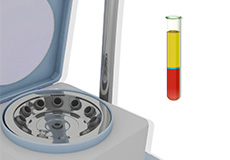
Platelet Rich Plasma
Our blood consists of a liquid component known as plasma. It also consists of three main solid components which include red blood cells (RBCs), white blood cells (WBCs), and platelets. Platelets play an important role in forming blood clots. They also consist of special proteins, known as growth factors, which help with our body's healing process.
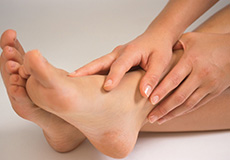
Foot Care
The feet support our body weight, help maintain proper posture and help in movement. As the feet bear the entire weight of the body and are involved in most activities, they are more prone to problems such as calluses, corns, cracks, infections and traumatic injuries. To maintain healthy feet, you should always wear comfortable, good quality and properly fitting footwear.
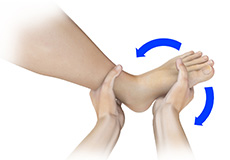
Foot Activity & Exercise Guide
A foot injury or foot surgery may leave you immobile for a period of time. To return to your regular activities and more strenuous recreational activities, it is necessary for you to follow a well-planned activity and exercise program.
Surgical Treatments

Bunion Surgery or Bunionectomy
A bunion, also known as hallux valgus, is bony prominence at the base of the big toe, which often results in pain, redness and rubbing in footwear. The 1st metatarsal bone abnormally angles outward towards the other foot from its joint in the midfoot. A bunion can change the shape of your foot, make it difficult for you to find shoes that fit correctly and worsen the symptoms if left untreated.
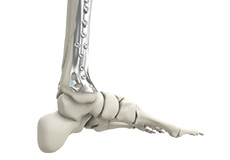
Foot Reconstruction
Foot reconstruction is a surgery performed to correct the structures of the foot and restore the natural functionality of the foot that has been lost due to injury or illness. Ideally, any foot surgery for reconstruction is done to improve the appearance and function of the foot so that patients can maintain their quality of life.
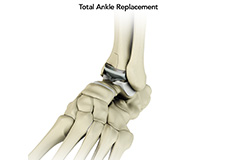
Total Ankle Replacement
The ankle joint connects the leg with the foot and provides free movement to the foot. It is formed by connecting the bones of the lower leg, tibia and fibula, with the talus, or ankle bone.
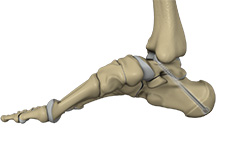
Subtalar Arthrodesis
Subtalar arthrodesis is the surgical fusion of bones that form the subtalar joint. The subtalar joint is a complex joint located below the ankle joint and is formed by the union of the heel (calcaneus) and the talus (ankle) bone. The subtalar joint allows side-side movement of the foot.
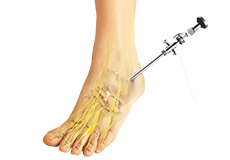
Ankle Arthroscopy
Ankle arthroscopy is a minimally invasive surgical procedure in which an arthroscope, a small, soft, flexible tube with a light and video camera at the end, is inserted into the ankle joint to evaluate and treat a variety of conditions.
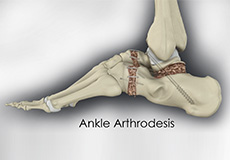
Ankle Arthrodesis
Ankle arthrodesis is the surgical fusion of bones that form the ankle joint. The ankle joint is formed by the tibia, talus, and the fibula bones.
The goal of ankle arthrodesis is to relieve pain in the affected joint. This is achieved by surgically eliminating the joint.
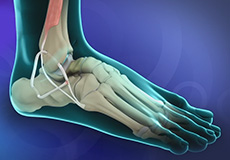
Ankle Ligament Reconstruction
A sprain is the stretching or tearing of a ligament. Ligaments connect adjacent bones in a joint and provide stability to the joint.
An ankle sprain is a common injury and occurs when you fall or suddenly twist the ankle joint or when you land your foot in an awkward position after a jump.
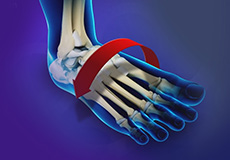
Ankle Instability Surgery
Ankle instability is a chronic condition characterized by a recurrent slipping of the outer side of the ankle. Instability is generally noticed during movement of the ankle joint but can also occur during standing as well.
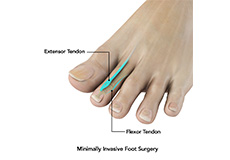
Minimally Invasive Foot Surgery
Minimally Invasive Foot Surgery (MIFS) uses the latest advanced technology to treat foot and ankle pain caused by a variety of conditions. Special surgical instruments, devices and advanced imaging techniques are used to visualize and perform the surgery through small incisions.
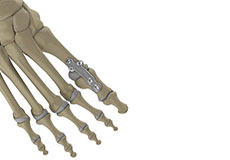
1st MTP Fusion (Arthrodesis)
First MTP joint fusion, or arthrodesis, is a surgical procedure that permanently fuses the bones of the big toe joint, eliminating motion to relieve pain caused by advanced hallux rigidus (big toe arthritis).
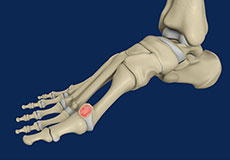
Minimally Invasive Cheilectomy
A cheilectomy is a surgical procedure to remove bone spurs and clean the joint surface of the first metatarsophalangeal (1st MTP) joint, commonly affected by hallux rigidus, or big toe arthritis.
Tratamientos No Quirúrgicos

Plasma Rico en Plaquetas
Nuestra sangre consiste en un componente líquido conocido como plasma. También consiste en tres componentes sólidos principales que incluyen glóbulos rojos (RBCs), glóbulos blancos (WBCs) y plaquetas. Las plaquetas juegan un papel importante en la formación de coágulos sanguíneos.

Cuidado del Pie
Los pies soportan el peso de nuestro cuerpo, ayudan a mantener la postura adecuada y contribuyen al movimiento. Como los pies soportan todo el peso del cuerpo y están involucrados en la mayoría de las actividades, son más propensos a problemas como callos, durezas, grietas, infecciones y lesiones traumáticas.

Guía de Actividad y Ejercicio para el Pie
A foot injury or foot surgery may leave you immobile for a period of time. To return to your regular activities and more strenuous recreational activities, it is necessary for you to follow a well-planned activity and exercise program.
Tratamientos Quirúrgicos

Cirugía de Juanetes o Bunionectomía
Un juanete, también conocido como hallux valgus, es una prominencia ósea en la base del dedo gordo del pie, que a menudo resulta en dolor, enrojecimiento y roce con el calzado. El primer hueso metatarsiano se inclina anormalmente hacia afuera respecto al otro pie desde su articulación en el mediopié.

Reconstrucción del Pie
La reconstrucción del pie es una cirugía realizada para corregir las estructuras del pie y restaurar la funcionalidad natural del pie que se ha perdido debido a una lesión o enfermedad. Idealmente, cualquier cirugía de reconstrucción del pie se realiza para mejorar la apariencia y función del pie, de modo que los pacientes puedan mantener su calidad de vida.

Reemplazo Total de Tobillo
La articulación del tobillo conecta la pierna con el pie y proporciona libre movimiento al pie. Las superficies de los huesos del tobillo están cubiertas con cartílago articular. El daño a este cartílago causa artritis, lo que resulta en dolor y movimiento deteriorado del tobillo.

Artrodesis Subastragalina
La articulación subastragalina es una articulación compleja ubicada debajo de la articulación del tobillo y está formada por la unión del talón (calcáneo) y el hueso astrágalo (tobillo).

Artroscopia de Tobillo
Para ayudarte a hablar sobre la cirugía de artroscopia de tobillo como una opción de tratamiento con tu cirujano ortopédico, aquí tienes un desglose de este procedimiento quirúrgico.

Artrodesis de Tobillo
La artrodesis de tobillo es la fusión quirúrgica de los huesos que forman la articulación del tobillo. La articulación del tobillo está formada por los huesos tibia, astrágalo y peroné.
El objetivo de la artrodesis de tobillo es aliviar el dolor en la articulación afectada. Esto se logra eliminando quirúrgicamente la articulación.

Reconstrucción de Ligamentos del Tobillo
Cirugía de Reconstrucción de Ligamentos del Tobillo para Restaurar la Función del Tobillo
Para ayudarle a discutir la cirugía de reconstrucción de ligamentos del tobillo como una opción de tratamiento con su cirujano ortopédico, aquí tiene un desglose de este procedimiento quirúrgico.

Cirugía de Inestabilidad de Tobillo
La inestabilidad de tobillo es una condición crónica caracterizada por recurrentes deslizamientos del lado externo del tobillo. La inestabilidad generalmente se nota durante el movimiento de la articulación del tobillo, pero también puede ocurrir al estar de pie.

Cirugía de Pie Mínimamente Invasiva
La cirugía de pie mínimamente invasiva (MIFS, por sus siglas en inglés) utiliza la última tecnología avanzada para tratar el dolor de pie y tobillo causado por una variedad de condiciones. Se utilizan instrumentos quirúrgicos especiales, dispositivos y técnicas de imagen avanzadas para visualizar y realizar la cirugía a través de pequeñas incisiones.

Fusión de la 1.ª Articulación Metatarsofalángica (Artrodesis)
La fusión de la primera articulación metatarsofalángica (MTP), o artrodesis, es un procedimiento quirúrgico que fusiona permanentemente los huesos de la articulación del dedo gordo, eliminando el movimiento para aliviar el dolor causado por hallux rigidus avanzado (artritis del dedo gordo).

Queilectomía Mínimamente Invasiva
Una queilectomía es un procedimiento quirúrgico para eliminar espolones óseos y limpiar la superficie articular de la primera articulación metatarsofalángica (1.ª MTP), que suele verse afectada por el hallux rigidus (artritis del dedo gordo).
